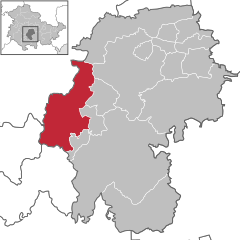Geratal | |
|---|---|
| Coordinates: 50°45′N10°49′E / 50.750°N 10.817°E Coordinates: 50°45′N10°49′E / 50.750°N 10.817°E | |
| Country | Germany |
| State | Thuringia |
| District | Ilm-Kreis |
| Area | |
| • Total | 82.33 km2 (31.79 sq mi) |
| Elevation | 490 m (1,610 ft) |
| Population (2017-12-31) [1] | |
| • Total | 8,991 |
| • Density | 110/km2 (280/sq mi) |
| Time zone | CET/CEST (UTC+1/+2) |
| Postal codes | 98716, 99330, 99338 |
| Dialling codes | 036205, 036207, 03677 |
| Vehicle registration | IK |
Geratal is a municipality in the district Ilm-Kreis, in Thuringia, Germany. It was created with effect from 1 January 2019 by the merger of the former municipalities of Frankenhain, Geraberg, Geschwenda, Gossel, Gräfenroda and Liebenstein. The name refers to the river Gera.

Municipalities are the lowest level of official territorial division in Germany. This is most commonly the third level of territorial division, ranking after the Land (state) and Kreis (district). The Gemeinde which is one level lower in those states also includes Regierungsbezirke as an intermediate territorial division. The Gemeinde is one level higher if it is not part of a Samtgemeinde. Only 10 municipalities in Germany have fifth level administrative subdivisions and all of them are in Bavaria. The highest degree of autonomy may be found in the Gemeinden which are not part of a Kreis. These Gemeinden are referred to as Kreisfreie Städte or Stadtkreise, sometimes translated as having "city status". This can be the case even for small municipalities. However, many smaller municipalities have lost this city status in various administrative reforms in the last 40 years when they were incorporated into a Kreis. In some states they retained a higher measure of autonomy than the other municipalities of the Kreis. Municipalities titled Stadt are urban municipalities while those titled Gemeinde are classified as rural municipalities.

Ilm-Kreis is a district in Thuringia, Germany. It is bounded by the city of Erfurt, the districts of Weimarer Land, Saalfeld-Rudolstadt and Hildburghausen, the city of Suhl, and the districts of Schmalkalden-Meiningen and Gotha. It is named after the river Ilm, flowing through the district.

Thuringia, officially the Free State of Thuringia, is a state of Germany.





















